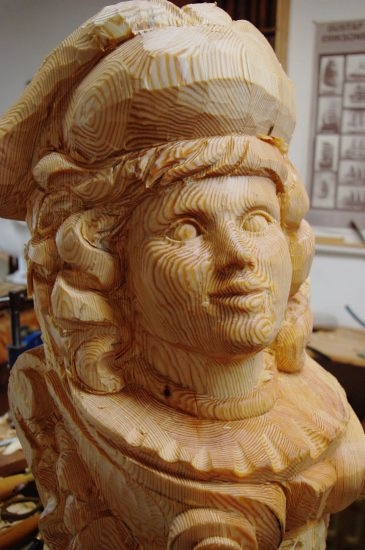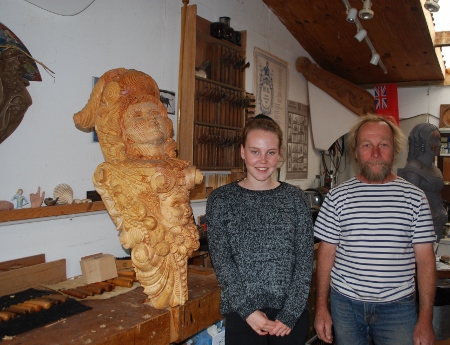Historic art of marine carving alive and well in Oxfordshire
On 16/08/2017 At 12:16 am
Category : Missed a ThameNews story?, More News, Thame news
Responses : No Comments

HIDDEN away in a corner of Waterperry Garden Centre is a small community of artist-craft workers, among them a unique talent, keeping alive the venerable tradition of maritime carving. Thame.net’s summer intern, Gabby Smith, recently visited the workshop of Andy Peters, who created Maritima Woodcarving back in 1990. Here she writes about the experience and the unforgettable impressions the visit left her with:
I recently visited Andy’s workshop in Waterperry where he carves the most beautiful ship’s figureheads. The complexity of his work is the aspect I found most impressive; these large-scale figureheads that have the most intricate detail, often off fish, birds, leaves, shells and usually female faces. Andy’s background in wood carving started from the age of eleven when his furniture-maker father brought him his own set of carving tools to stop Andy stealing his! Andy is completely self-taught, developing an interest in maritime carving later when he crewed aboard sailing ships delivering them around the world. Before that, Andy had mostly earned a living carving picture frames.
Andy explained to me that the process of creating a maritime wood carving is a long one that begins with a request from a client, from which he first sketches ideas, then builds a small prototype or ‘maquette’ to work from. Then begins the carving of the full size figure which can get so large that he has to finish it on site, at the ship yard. Looking around Andy’s workshop, I also saw that he had made some replicas of old, original statues and figure heads that clients had requested, using special techniques like colouring the wood so that it looks as though the ravages of time have deteriorated the wood, just like the original museum version.
The wood used for Andy’s pieces is ethically sourced, mostly from Sweden where they plant more trees than they take down. Most of his works use the so-called Dutch technique of gluing layers of board together to build up the overall shape and then carving back to match the measurements taken from the original. The work that established Andy’s reputation as an authority on authentic wood carving was working in Sweden on the Götheborg, a sailing replica of a Swedish East India ship from 1738. Andy was commisioned to research and create designs for the stern decoration and figurehead. This led to a period of six years as the ship’s wood carver, completing all of the decorations for the ship. The lion figurehead for the Götheborg stands 15ft (4.6m) tall and was started from three tons of timber.
One of Andy’s most impressive achievements is his book, published in 2010 – ‘Ship Decoration 1630-1780’ which took him nine years to research, write and create all the illustrations which he did himself. It has now become the authoritative book on the subject. In the book Andy explains how art and wood sculptures were adapted for ships. Before 1780, all ship yards would have had their own sculptor and amazingly, one third of the cost of building a ship was in the decoration. However, after 1780, people became more interested in the efficiency of the ship rather than the decoration and so some of maritime wood carving was lost as fewer ships had figureheads on the front, as it was felt it slowed them down.
 “On his website, Maritima Woodcarving, you can see that Andy’s skills don’t stop at figureheads; from restoration to trailboards there is an array of examples of how Andy works with wood to carve the most beautiful designs, and his commitment to keeping the art of ship carving alive is obvious. His aim continues to be to ‘learn all aspects of this almost forgotten art’, and through his historical research showcased in his book, and his dedication to carving, it’s clear that maritime carving lives on in this corner of Oxfordshire.
“On his website, Maritima Woodcarving, you can see that Andy’s skills don’t stop at figureheads; from restoration to trailboards there is an array of examples of how Andy works with wood to carve the most beautiful designs, and his commitment to keeping the art of ship carving alive is obvious. His aim continues to be to ‘learn all aspects of this almost forgotten art’, and through his historical research showcased in his book, and his dedication to carving, it’s clear that maritime carving lives on in this corner of Oxfordshire.
Gabby Smith


